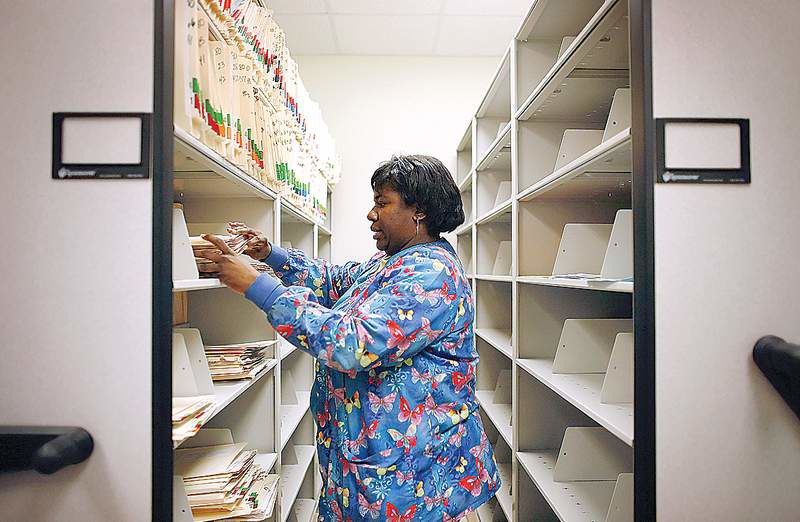Expanded clinics are a success for Bush
Published 4:00 am Friday, December 26, 2008

- Charmissa Johnson works in the records room at the Southside Family Clinic in Nashville, Tenn. The clinic moved into a new building last year, but Nashville’s community clinics still meet just a third of the need among the city’s urban poor and immigrants.
NASHVILLE, Tenn. — Although the number of uninsured and the cost of coverage have ballooned under his watch, President Bush leaves office with a health care legacy in bricks and mortar: He has doubled federal financing for community health centers, enabling the creation or expansion of 1,297 clinics in medically underserved areas.
For those in poor urban neighborhoods and isolated rural areas, including Indian reservations, the clinics are often the only dependable providers of basic services like prenatal care, childhood immunizations, asthma treatments, cancer screenings and tests for sexually transmitted diseases.
Despite the clinics’ unprecedented growth, wide swaths of the country remain without access to affordable primary care. The recession has only magnified the need as hundreds of thousands of Americans have lost their employer-sponsored health insurance along with their jobs.
In response, Democrats on Capitol Hill are proposing even more significant increases, making the centers a likely feature of any health care deal struck by Congress and the Obama administration.
In Nashville, United Neighborhood Health Services, a 32-year-old community health center, has seen its federal financing rise to $4.2 million, from $1.8 million in 2001. That has allowed the organization to add eight clinics to its base of six, and to increase its pool of patients to nearly 25,000 from 10,000. Still, says Mary Bufwack, the center’s chief executive, the clinics satisfy only a third of the demand in Nashville’s pockets of urban poverty and immigrant need.
One of the group’s recent grants helped open the Southside Family Clinic, which moved last year from a pair of public housing apartments to a gleaming new building on a once derelict corner.
As she completed a breathing treatment one recent afternoon, Willie Mai Ridley, a 68-year-old beautician, said she would have sought care for her bronchitis in a hospital emergency room were it not for the new clinic. Instead, she took a short drive, waited 15 minutes without an appointment and left without paying a dime; the clinic would bill her later for her Medicare co-payment of $18.88.
Ridley said she appreciated both the dignity and the affordability of her care. “This place is really very, very important to me,” she said, “because you can go and feel like you’re being treated like a person, and get the same medical care you would get somewhere else and have to pay $200 to $300.”
As governor of Texas, Bush came to admire the missionary zeal and cost-efficiency of the not-for-profit community health centers, which qualify for federal operating grants by being located in designated underserved areas and treating patients regardless of their ability to pay. He pledged support for the program while campaigning for president in 2000 on a platform of “compassionate conservatism.”
In Bush’s first year in office, he proposed to open or expand 1,200 clinics over five years (mission accomplished) and to double the number of patients served (the increase has ended up closer to 60 percent). With the health centers now serving more than 16 million patients at 7,354 sites, the expansion has been the largest since the program’s origins in President Lyndon B. Johnson’s war on poverty, federal officials said.
“They’re an integral part of a health care system because they provide care for the low income, for the newly arrived, and they take the pressure off of our hospital emergency rooms,” Bush said last year while touring a clinic in Omaha, Neb.
Federal push
With federal encouragement, the centers have made a major push this decade to expand dental and mental health services, open on-site pharmacies, extend hours to nights and weekends, and accommodate recent immigrants — legal and otherwise — by employing bilingual staff. More than a third of patients are now Hispanic, according to the National Association of Community Health Centers.
The centers now serve one of every three people who live in poverty and one of every eight without insurance. But a study released in August by the Government Accountability Office found that 43 percent of the country’s medically underserved areas lack a health center site. The National Association of Community Health Centers and the American Academy of Family Physicians estimated last year that 56 million people were “medically disenfranchised” because they lived in areas with inadequate primary care.
President-elect Barack Obama has said little about how the centers may fit into his plans to remake American health care. But he was a sponsor of a Senate bill in August that would quadruple federal spending on the program — to $8 billion from $2.1 billion — and increase incentives for medical students to choose primary care. His wife, Michelle, worked closely with health centers in Chicago as vice president for community and external relations at the University of Chicago Medical Center.
Recent job losses, meanwhile, are stoking demand for the clinics’ services, often from first-time users. The United Neighborhood Health Services clinics in Nashville have seen a 35 percent increase in patients this year, with much of the growth from the newly jobless.
“I’m seeing a lot of professionals that no longer have their insurance, or they’re laid off from their jobs,” said Dr. Marshelya Wilson, a physician at the center’s Cayce clinic. “So they come here and get their health care.”





